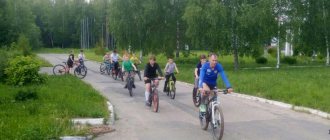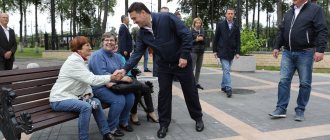For other places with the same name, see Navoloki.
City in Ivanovo region, Russia
| Navoloks Navoloks | |
| City [1] | |
| View of Navoloki | |
| Flag Coat of arms | |
| Location of Navoloka | |
| Navoloki Location of Navoloka Show map of Russia Navoloki Navoloki (Ivanovo region) Show map of Ivanovo region | |
| Coordinates: 57°28'N 41°58'E / 57.467°N Latitude 41.967°E / 57.467; 41.967 Coordinates: 57°28'N 41°58'E. / 57.467°N Latitude 41.967°E / 57.467; 41,967 | |
| A country | Russia |
| Federal subject | Ivanovo region [1] |
| Administrative region | Kineshma district [1] |
| Based | 1880s |
| City status from | 1938 |
| Height | 120 m (390 ft) |
| population size (2010 Census) [2] | |
| • General | 10 206 |
| • Evaluate (2018) [3] | 9 374 ( -8,2% ) |
| Municipal status | |
| • Municipal district | Kineshma municipal district [4] |
| • Urban village | Urban settlement Navolokskoye [4] |
| • Capital from | Urban settlement Navolokskoye [4] |
| Timezone | UTC+3 (MSK[5]) |
| Postal code [6] | 155830, 155831 |
| OKTMO ID | 24611104001 |
| Web site | www.navoloki.ru |
Navoloki
(Russian: Navoloki) is a city in the Kineshma District of Ivanovo Oblast, Russia, located on the right bank of the Volga River, 120 km (75 mi) northeast of Ivanovo, the administrative center of the region. Population: 10,206 (2010 census); [2] 11,248 (2002 census); [7] 12,434 people (1989 census). [8]
Administrative and municipal status[edit]
Administratively, Navoloki is subordinate to the Kineshma district. [1] Before the adoption of Law No. 145-OZ “ On the administrative-territorial division of the Ivanovo region”
in December 2010 it was separately formed as an administrative unit with a status equal to that of districts. [9]
In the municipal division, the city of Navoloka, together with eighteen rural settlements in the Kineshemsky district, is included in the Kineshemsky municipal district as a Navolokskoye urban settlement
. [4]
The city of Navoloki is a city of regional subordination to the Kineshma district of the Ivanovo region. Located on the right bank of the Volga River, 105 km from the city of Ivanovo, 10 km from the regional center of Kineshma. It borders in the east with the city of Kineshma, in the north with the Zavolzhsky district, in the southwest with the Vichugsky district, in the southeast with the Gorky settlement of the Kineshma district. The city of Navoloki is located on the picturesque banks of the Volga, is one of the environmentally favorable regions of Russia and has rich recreational opportunities with water and forest resources, landscapes and healing springs.
The name of the city did not appear by chance. At the place where Navoloki , there lay a lowland, surrounded by high hills, and an island opposite, dividing the river into two channels. The Upper Volga region was considered the outskirts of Slavic lands; the Merya tribe lived here. The first mention of the territories appears in the acts of 1775, where the following description of the village of Navolok is given. “The village of Navolok, Ivan Mikhailovich, son of Koloshin and Ivan Fedorovich Khrushchev. The number of households is 8. According to the audit of the souls, there are 19 men, 19 women. Under the estate - 1 dessiatines, 1900 fathoms. Arable land 94 dessiatines, 6 hay fields, 7 forests, 14 inconvenient places, in total - 123 dessiatines and 1492 fathoms. In the same 1775, during the General Land Survey of the Kineshma district of the Kostroma province, not only the village of Navoloki was mentioned, but also the presence in it of the Church of the Assumption of the Blessed Virgin Mary . In 1875, there were only 19 households in Navoloki, with 76 male and female souls living in them. There were no streets then. There were small houses. There were 16 houses in Kalachevo. There was, however, a two-story house of the forest owner Tsvetkov and a Rhine wine cellar - they sold citro and red wines here, which, by the way, were excellent. 1880 – a historical milestone in the development of Navolok : Vichuga merchants P.G. Mindovsky and I.A. Bakakin are building a small weaving factory in the village. The day of the signing of the Tsar's Decree on the establishment of the "Partnership of the Volga Manufactory of Paper and Linen Products" - June 27, 1880 is considered the birthday of the cotton mill "Privolzhskaya Communa", now LLC "Navtex" - the main city-forming enterprise of the city. In 1935, the working settlement of Navoloki became a regional center and existed until 1958. In May 1938, by the Decree of the Presidium of the Supreme Council, the village of Navoloki received the status of a city. In 2005, the Navolokskoye urban settlement was formed. Phone code: +7 49331 City websites: https://navoloky.narod.ru, www.gorodnavoloki.ru; Navoloki urban settlement: www.navoloki.ru
Links[edit]
Notes[edit]
- ^ abcd State Committee of the Russian Federation on Statistics. Committee of the Russian Federation for Standardization, Metrology and Certification. No. OK 019-95 January 1, 1997 “All-Russian classifier of objects of administrative-territorial division. Code 24 211 504", as amended. changes No. 278 / 2015 dated January 1, 2016. (Goskomstat of the Russian Federation. Committee of the Russian Federation for Standardization, Metrology and Certification. No. OK 019-95 January 1, 1997. Russian classification of administrative divisions) (OKATO).
Code 24 211 504 , as amended by Amendment No. 278/2015 of January 1, 2016). - ^ a b Federal State Statistics Service (2011). “All-Russian Population Census 2010. Volume 1" [All-Russian Population Census 2010, vol. 1]. All-Russian Population Census 2010 [All-Russian Population Census 2010]
. Federal State Statistics Service. - "26. The size of the permanent population of the Russian Federation by municipalities as of January 1, 2022". Federal State Statistics Service. Retrieved January 23, 2022.
- ^ abcd Law No. 42-OZ
- "On the Calculation of Time". Official Internet portal of legal information
. June 3, 2011. Retrieved January 19, 2022. - Post office. Information and computing center of OASU RPO. ( Post office
).
Search for postal service objects ( postal Search for objects
) (in Russian) - ↑
Federal State Statistics Service of Russia (May 21, 2004).
“The population of Russia, the constituent entities of the Russian Federation as part of federal districts, urban settlements, settlements, settlements is 3 thousand or more people” [Population of Russia, its federal districts, federal districts, districts Urban settlements, rural settlements - administrative centers and rural settlements with a population of over 3,000] (XLS). All-Russian Population Census 2002
. - “All-Union Population Census of 1989. The current population of union and autonomous republics, autonomous regions and districts, territories, negative phenomena, urban settlements and rural district centers” [All-Union Population Census of 1989: current population of union and autonomous republics, Autonomous regions and districts , territories, regions, districts, towns and villages performing the functions of district administrative centers. All-Union Population Census of 1989 [All-Union Population Census of 1989]
.
Institute of Demography of the National Research University: Higher School of Economics [Institute of Demography of the National Research University: Higher School of Economics]. 1989 - via Demoscope Weekly
. - Law No. 27-OZ
Sources [edit]
- Legislative Assembly of the Ivanovo region. Law No. 27-OZ of March 31, 2003 “On the administrative-territorial structure of the Ivanovo region,” as amended. Law No. 51-OZ of May 21, 2009 “On Amendments to Articles 13, 22 and 27 of the Law “On the Administrative-Territorial Structure of the Ivanovo Region””. Came into force on the date of official publication. Published: “Collection of Legislation of the Ivanovo Region”, No. 7 (217), April 15, 2003 (Legislative Assembly of the Ivanovo Region. Law No. 27-OZ of March 31, 2003 “ On the administrative-territorial structure of the Ivanovo Region”
as amended Law of May 21, 2009 No. 51-OZ “
On Amendments to Articles 13, 22 and 27”).
Law “On the administrative-territorial structure of the Ivanovo region” . Valid from the date of official publication.). - Legislative Assembly of the Ivanovo region. Law No. 42-OZ of February 25, 2005 “On urban and rural areas in the Kineshma municipal district,” as amended. Law No. 123-OZ of October 28, 2008 “On Amendments and Additions to the Law of the Ivanovo Region” On Urban and Rural Settlements in the Kineshma Municipal District “”. Came into force 10 days from the date of official publication. Published: “Laws of the Ivanovo Region and Documents of the Legislative Assembly”, No. 1 (166), February 28, 2005 (Legislative Assembly of the Ivanovo Region. Law of February 25, 2005 No. 42-OZ “ On urban and rural settlements in the Kineshma municipal district "
as amended by Law No. 123-OZ of October 28, 2008
On amendments and additions to the Law of the Ivanovo Region “On Urban and Rural Settlements in the Kineshma Municipal District"
. Valid from the date that is 10 days from the date of official publication.).
Navoloki - the beginning of the life of this ancient Russian city was laid by the Krivichi
November 25, 2013, 11:27 / News / Russian style / Russian house / 10193.html
The city of Navoloki is located on the right bank of the Volga River in the Ivanovo region, 16 km west of the city of Kineshma and 120 km northeast of Ivanovo. It is known from history that the very first mention of Navoloki was noted in 1775 as a small village with the Church of the Assumption of the Blessed Virgin Mary.
Most researchers are inclined to believe that the name Navoloka goes back to the word “sediment,” that is, what was “applied, deposited,” namely by the Volga River, near which this village is located. This process can be explained by the usual “bend” of the river, a turn. As a result of the fast current, sand spits were dragged onto the banks.
Story
The life of Navolok began with the Krivichi, who occupied these lands since the 9th century. The presence of a reservoir, forests and fields, fur-bearing animals, fish, mushrooms and berries - all this attracted people here. From the 16th century Most of the arable land (which then belonged to the Kostroma province) belonged to the Romanov dynasty. In 1880, in the village of Navoloki, Vichuga merchants P.G. Mindovsky and I.A. Bakakin built the weaving factory of the Volga Manufactory of Paper and Linen Products. Raw materials for processing were obtained from neighboring Kostroma and Yuryevets. Egypt and America were regular suppliers of cotton. One of the great attractions of the city of Navoloka is the Church of the Assumption of the Blessed Virgin Mary, which was founded in 1785 at the expense of a local landowner, Ivan Mikhailovich Koloshin. Empress Alexandra Feodorovna donated an icon of St. Nicholas to the temple, and Empress Maria Alexandrovna donated an icon of the Mother of God of the “Fryazh script”. The Dolgoruky princes, close to the royal family, also made significant investments: 60 pieces of holy relics, stored in a gilded case behind glass, and a cypress cross. The main attraction of the church was the miraculous icon of the Dormition of the Mother of God (Greek writing, in a silver robe). It is not known where this shrine is located at this time.
What to see
Church of the Assumption of the Blessed Virgin Mary (1785), weaving factory complex (1880), residential and public buildings (19th century)
And further
On the opposite bank of the Volga, at the mouth of the Kistega River, on the left bank, there is the holy Nikolenkin spring. At the beginning of the 21st century. A chapel was built above the spring, and baths nearby. According to legend, the water in the source is healing. Helps with diseases of the organs of vision. Three km from the city of Navoloka there is a sanatorium named after. Stanko, famous for its mineral springs (the administrative building is located in the building of a former merchant estate of the 19th century).
Travel: by train from Yaroslavsky station to Kineshma, then by bus. By car – along the Gorkovskoye Highway through Ivanovo.
The rest of the photos are in the photo gallery .
Navoloki
The first mention of the village of Navoloki is in Issue 5 “For the Kostroma and Plesskaya tithes of the Kostroma district” for 1912 (p. 93), where the year 1623 is mentioned.
The description of the village of Navolok is contained in the acts of 1775:
Seltso Navolok Ivan Mikhailovich son of Koloshin and Ivan Fedorovich Khrushchev. The number of households is 8. According to the soul audit, there are 19 men, 19 women, under the estate - 1 dessiatines, 1,900 fathoms. Arable land 94 dessiatines, 6 hay fields, 7 forests, 14 inconvenient places, in total - 123 dessiatines and 1,492 fathoms.
In the same 1775, during the General Land Survey of the Kineshma district of the Kostroma province, the village of Navoloki and the Church of the Assumption of the Blessed Virgin Mary located in it were mentioned.
The “Reference Book” published by the Kostroma diocese in 1911 gives a description of the lands:
Church lands used by the clergy: estate - 1780 sq. fathoms, arable land - 33 dessiatinas, hayfields - 1270 sq. m. fathoms In addition, there is 1 tithe of 544 sq. m. fathoms of land donated by the priest Lyubimogradsky. The parishioners are 968 male and 1143 female. The parish has a mixed occupation: agricultural and factory. There are 20 parish villages, of which the most distant ones are 7 miles from the church. In the parish in the village. I brought two two-class schools: a parish school and a Ministry of Public Education school, and one one-class zemstvo school.”
In 1875, there were 19 households and 76 residents in Navoloki.
In 1880, Vichuga merchants P.G. Mindovsky and I.A. Bakakin founded a small weaving factory in the village of Navoloki. June 27, 1880, the day of the signing of the Tsar’s Decree on the establishment of the “Partnership of the Volga Manufactory of Paper and Linen Products” is considered the birthday of the Privolzhskaya Communa cotton mill, now LLC Navtex, the main city-forming enterprise of the settlement. The city appeared and grew thanks to this textile giant.
The start of construction of this factory in 1880 is indicated by an entry in the book “Legalization and Government Order”:
The Sovereign Emperor, according to the position of the Committee of Ministers, deigned to give permission to the hereditary citizen of the city of Kineshma of the 1st guild, merchant Pyotr Galaktionovich Mindovsky, and the Yuryevets 1st guild merchant Ivan Aleksandrovich Bakakin, to establish a partnership on shares called “Partnership of the Volga Minor of Paper and Linen Products P. Mindovsky and I. Bakakin, on the basis of the charter, awarded the Highest consideration and approval on the 27th day of June 1880.
The floors, beams, ceilings and columns were made of wood. Weaving looms and other equipment were driven through transmissions by two steam engines with a power of 350 and 150 horsepower. At first the factory produced only linen canvases. Soon the production of paper fabrics also began. The raw materials were flax from Yuryevets and Kostroma and cotton from Egypt and America. They produced paper and linen yarn, linen, semi-linen and paper canvases, patterned and openwork fabrics. The range also included towels, sheets, scarves and tablecloths.
Manufacturers bought arable land, land, forests, and lands along the Volga coast from bankrupt landowners and peasants in the Navolok region. In a short time they acquired about 1,400 acres of land. New buildings were built on it at a rapid pace. The number of weaving machines and the volume of fixed capital grew. If in 1880 the factory had 300 machines, then six years later it had more than three times as many. By 1894, the fixed capital had quadrupled and amounted to more than 1 million rubles. This capital annually yielded a profit of 20% or more. In 1890, the factory employed 1,300 workers, making it one of the largest factories in the country. In comparison, in Kineshma, in nine factories and factories, the total number of employees was 1,748 people.
Since 1925, Navoloki has been a working village.
In 1935-1958, Navoloki was the regional center of the Navoloksky district of the Ivanovo region.
In May 1938, by the Decree of the Presidium of the Supreme Soviet of the USSR, the workers' village of Navoloki received the status of a city[4].








